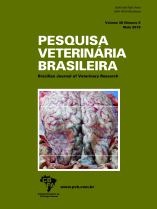 |
|
|
|
Year 2018 - Volume 38, Number 5
|

|
Anatomopathological aspects and determination of infectious agents in 32 cats with cholangiohepatitis, 38(5):920-929
|
ABSTRACT.- Argenta F.F., Rolim V.M., Lorenzo C., Snel G.G.M., Pavarini S.P., Sonne L. & Driemeier D. 2018. [Anatomopathological aspects and determination of infectious agents in 32 cats with cholangiohepatitis.] Aspectos anatomopatológicos e avaliação de agentes infecciosos em 32 gatos com colângio-hepatite. Pesquisa Veterinária Brasileira 38(5):920-929. Setor de Patologia Veterinária, Departamento de Patologia Clínica Veterinária, Faculdade de Veterinária, Universidade Federal do Rio Grande do Sul, Av. Bento Gonçalves 9090, Prédio 42505, Porto Alegre, RS 91540-000, Brazil. E-mail: davetpat@ufrgs.br
Cholangiohepatitis is considered a frequent cause of liver failure in cats, and are classified as neutrophilic, lymphocytic and sclerosing. The aims of this study was to determine the frequency of cholangiohepatitis in cats diagnosed in the metropolitan region of Porto Alegre, to describe the anatomopathological aspects and to establish an association with Escherichia coli, feline immunodeficiency virus (FIV) and feline leukemia virus (FeLV). From January 2000 to July 2016, the Department of Veterinary Pathology of the Universidade Federal do Rio Grande do Sul performed 1915 cat necropsies, of which 32 were diagnosed with cholangiohepatitis, representing 1.7% of the cases. Of these, lymphocytic cholangiohepatitis (LCH) was diagnosed in 68.7% (22/32), neutrophilic (NCH) in 21.9% (7/v) and sclerosing cholangiohepatitis (SCH) with 9.4% (3/32) of the cases. In general, age ranged from four months to 16 years, with the median age of six years, and predominantly affected cats with mixed breed. Only in NCH demonstrated male predisposition, verified in 85.7% (6/7) of this cases. Enteritis and pancreatitis were identified concomitantly with cholangiohepatitis in 56.2% (18/32) cases, each, and triad formation was identified in 46.9% (15/32) of cats. In the immunohistochemistry, we observed that 68.2% (15/22) of the cats with LCH were positive for FIV, 40.9% (9/22) for FeLV, and 31.8% (7/22) positive for both retroviruses. In NCH, 85.7% (6/7) was positive for FIV, 57.1% (4/7) for FeLV, and 42.8% (3/7) immunoreactions for the two retroviruses. In SCH, 100% (3/3) of the cases presented FeLV marking, 33.3% (1/3) for FIV and 33.3% (1/3) for both. Immunostaining for E. coli was observed in 27.3% (6/22) of LCH, 28.6% (2/7) of NCH, and 33.3% (1/3) of SCH. E. coli, Enterococcus sp. and Klebsiella pneumoniae were the most frequently microorganisms isolated in the bacteriological examination. The visualization of E. coli by the immunohistochemistry in the hepatobiliary system of cats diagnosed with cholangiohepatitis suggests that the disease developed secondary to ascending bacterial infection. |
| |
|
|
| |
|
 |